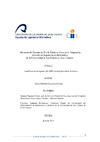Identificador persistente para citar o vincular este elemento:
https://accedacris.ulpgc.es/handle/10553/12179
| DC Field | Value | Language |
|---|---|---|
| dc.contributor.advisor | Quintana Domínguez, Francisca | - |
| dc.contributor.advisor | Tugores Cester, Antonio | - |
| dc.contributor.author | Guacarán Sabogal, Deyán Fabricio | - |
| dc.contributor.other | Escuela de Ingeniería Informática | en_US |
| dc.date.accessioned | 2014-09-16T02:30:56Z | - |
| dc.date.accessioned | 2018-06-04T14:13:11Z | - |
| dc.date.available | 2014-09-16T02:30:56Z | - |
| dc.date.available | 2018-06-04T14:13:11Z | - |
| dc.date.issued | 2014 | en_US |
| dc.identifier.uri | https://accedacris.ulpgc.es/handle/10553/12179 | - |
| dc.description.abstract | El ADN es un polímero que contiene la mayor parte de la información necesaria para el desarrollo y funcionamiento de todos los organismos vivos conocidos. La información está fraccionada en diferentes segmentos, los genes, que contienen variables que son individuales y que determinan las características de cada persona. Hay dos que son de especial importancia para la atención sanitaria: la susceptibilidad genética de padecer una enfermedad y la capacidad de responder de forma diferencial a un medicamento, denominado farmacogenética. Poder identificar dichas variantes puede ayudar a comprender la enfermedad e individualizar el tratamiento del paciente respectivamente. Para conocer estas variantes debemos conocer la secuencia de ADN de los genes implicados en las patologías o en las características farmacogenéticas para un individuo determinado, un proceso denominado secuenciación. Sin embargo, existen técnicas para seleccionar y secuenciar el exoma, que es la parte del genoma que contienen los exones, fracciones de los genes que contienen la información necesaria para la fabricación de las proteínas. La secuenciación de exoma cubre la mayor parte de los exones del genoma, pero no detecta algunas regiones, lo que imposibilita la detección de variantes en ellas. Este hecho crea una incertidumbre diagnóstica, lo que limita el poder de esta herramienta para la detección de mutaciones patogénicas. Así, el objetivo principal del Trabajo Fin de Grado es la creación de una herramienta informática que permita al personal clínico, la detección de regiones del exoma con poca cobertura de secuenciación, es decir, regiones del ADN con una frecuencia de lectura baja comparándolo con respecto al genoma de referencia. | en_US |
| dc.description.abstract | DNA is a polymer that contains most of the information necessary for the development and functioning of all known living organism. The information is fractionated into different segments, the genes, that it contains variables that are individual and determine the characteristics of each person. There are two that are specially importance for health care: genetic susceptibility to suffering disease and the ability to respond differentially to a drug, called pharmacogenetics. To identify variants can help to understand the disease and individualize the patient treatment respectively. For finding these variants, firstly we must know the DNA sequence of the genes involved in pathalogies or pharmacogenetic characteristics for a given individual, a process called sequencing. However, there are techniques for selecting and sequencing the exome, which is the part of the genome that contains the exons, fractions of genes that contain the necessary information for the productions of proteins. Exome sequencing covers most of the exons from genome, but it does not detect some regions, which makes impossible the detection of variants in them. This fact creates uncertainty diagnostic, which limits the capibility of this tool for the detection of pathogenic mutations. So, this main objective of this Final Degree Project is the creation of the software tool that allows to the clinicians, the detection of exome regions with low coverage sequencing, in other words, regions of DNA with a frequency of low reads comparing with respect to the reference genome. | en_US |
| dc.format | application/pdf | es |
| dc.language | spa | en_US |
| dc.rights | by-nc-nd | es |
| dc.subject | 120317 Informática | en_US |
| dc.title | Identificación de regiones del ADN con baja frecuencia de lectura | en_US |
| dc.type | info:eu-repo/semantics/bachelorThesis | en_US |
| dc.type | BachelorThesis | en_US |
| dc.compliance.driver | 1 | es |
| dc.contributor.departamento | Informática y Sistemas | en_US |
| dc.contributor.facultad | Escuela de Ingeniería Informática | en_US |
| dc.identifier.absysnet | 700338 | es |
| dc.investigacion | Ingeniería y Arquitectura | en_US |
| dc.rights.accessrights | info:eu-repo/semantics/openAccess | es |
| dc.type2 | Trabajo final de grado | en_US |
| dc.utils.revision | Sí | en_US |
| dc.identifier.matricula | TFT-30195 | es |
| dc.identifier.ulpgc | Sí | en_US |
| dc.contributor.titulacion | Grado en Ingeniería Informática | es |
| item.grantfulltext | open | - |
| item.fulltext | Con texto completo | - |
| crisitem.advisor.dept | GIR IUCES: Computación inteligente, percepción y big data | - |
| crisitem.advisor.dept | IU de Cibernética, Empresa y Sociedad (IUCES) | - |
| crisitem.advisor.dept | Departamento de Informática y Sistemas | - |
| Appears in Collections: | Trabajo final de grado | |
Page view(s)
256
checked on Nov 30, 2024
Download(s)
329
checked on Nov 30, 2024
Google ScholarTM
Check
Share
Export metadata
Items in accedaCRIS are protected by copyright, with all rights reserved, unless otherwise indicated.
